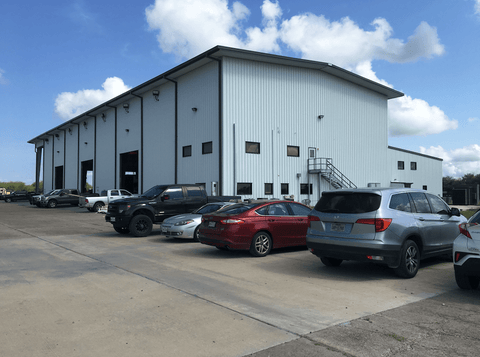Phone Booster Case Study: Victoria, TX 40k ft.² Manufacturing Facility
Nov 12, 2018

40,000 ft.² Manufacturing Facility in Victoria, Texas with little or no cellular signal.
Manufacturing area plus more than 8,000 ft.² of office to be covered.
Site Description
In Victoria, Texas, a 40,000 ft.² manufacturing facility encompassing a separate office wing of approximately 2,000 ft.² and two 4,000 ft.² office floors constructed one on top of the other. There was little or no cellular signal within the building.
Specific Problems with Cellular Connectivity
The owners of the manufacturing facility required reliable and good quality data and voice connectivity. They specifically required good quality "4G" cell phone signal within their facility. These were needed most urgently in office area, but reliable cellular connectivity was also required in the manufacturing area. As with many large constructions, the lack of 4G and LTE coverage within the building was primarily due to building materials. The building itself was constructed of corrugated metal and it also had a corrugated metal roof, thus creating a total interior cellular dead zone. Metallic buildings deflect wireless signals the most because metals are very dense materials. Their molecules in metals are extremely compact that result in their hardness. While this is great to protect the building from elements such as bad weather and storms, they prevent entry of mobile connectivity signals.
Therefore, unfortunately, most buildings constructed of corrugated metal experience the same issues with cell reception. In order to achieve any reliable cellular connection in these types of buildings the cell phone user is typically required to move close to a window and hold their smartphone as close as possible to the window. In essence, this 40,000 ft.² corrugated metal construction received no 4G coverage within the building.
Phone Booster Solution
To start with, our RF technicians carried out a detailed site survey across the building. Signal readings were taken both inside and outside the building to enable us to recommend the perfect cellular coverage amplifier for this specific building. In addition, our technicians charted the cable routes, as well as determined the best location to install the new cell phone signal amplifier based on survey tools.
It was determined that, because of the building materials used, the layout of the building, the size of the building, and other factors identified during the initial site survey, two SureCall Force 5 2.0 amplifiers in conjunction with 10 inside antenna be installed. The reason why this phone booster model was chosen is because it has ability to operate in larger buildings, whilst achieving strong external cellular signals without damaging or overloading the amplifier unit. In addition, this phone booster simultaneously supports multiple phones on multiple phone carrier networks.
Installation of the SureCall Force 5 2.0 Phone Booster System
Once the donor and server antennas and cable routes were identified, installation of the two phone boosters was carried out. Entire installation process was completed in such a manner as to ensure that the base signal boosting amplifier unit and its peripheral accessories were professionally installed in safe locations.
Phone boosters installed in electrical room:

Externally Visually Aesthetic, Neat and Clean Installation Completed
Every integration and installation we perform must meet our strict requirements of aesthetically pleasing visual appearance, to blend discreetly with the building design and architecture.
Exterior Omni-directional Donor or Server Antenna Close-up:

Appearance of same antenna from ground parking lot level:

Results
Following phone booster installation process, the results were instantaneous - as expected. The cell phone signal across the entire metal building was thoroughly tested, and reliable 3 to 4 bars of 4G LTL signal were received right throughout all areas of the building. The mobile connectivity system basically bypassed the metal walls and injected signals from outside via cable. They it boosted those signals inside the powerful phone booster and broadcasted them everywhere within building through the ten distributed antennas all across critical areas where there was no signal.
Are you in a similar situation? We provide phone booster installation nationwide. Call for FREE consultation: 1-855-846-2654. Or submit details using link above for a bill of materials and installation quote, to get started right away.
Share this post
3 comments


I read these case studies because they help me figure out what works in one situation and what works in another situation. I have observed that there are various case studies in Texas. Initially, I presumed the reason was due to Texas being such a big area and that cell towers might be spaced far apart. Reading these studies, the majority of cases in Texas seem to involve building materials hampering cell signals, thus the necessity for a cell phone booster.
I liked how the article mentioned this facility required, “reliable and good quality data and voice connectivity.” Who doesn’t require this? Anyone who has a smart phone wants these things. I understand the reasons why we don’t get them, but the statement seems redundant to me. Anyone else agree with me?
It seems like cell and wifi boosters are becoming common in businesses. I’ve read other articles like this that discuss the problems businesses face with their cell phones and wifi service due to the materials their facilities are made from. Some of these materials are notorious for blocking signals (just like when you go to the mall or you’re in an elevator somewhere) so I understand why people go to signal booster stores and get set up with phone boosters and/or wifi boosters. I wonder why building developers don’t do something about this before they construct a warehouse, plant, etc.